What Is a Solar Diesel Hybrid System?
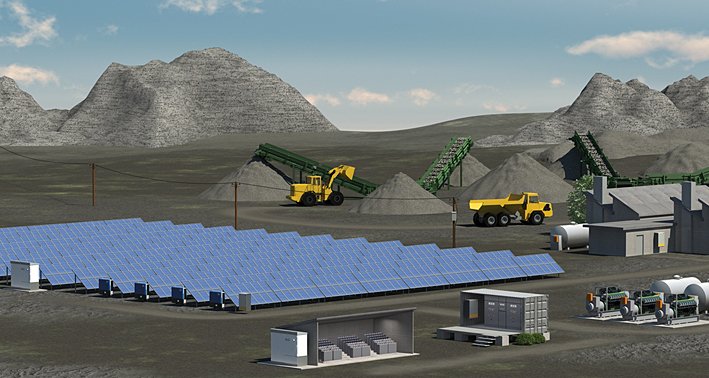
In many regions of the world, power grids are either inadequate or nonexistent. As a result, industrial consumers often ensure their power supply through diesel gensets. Five hundred gigawatts of power from diesel genset provide industrial companies with electricity worldwide. However, fuel costs for the gensets continue to rise.
In addition, if the fuel has to be transported to remote regions, the effective costs increase even more as a result of the necessary storage. At the same time, PV system costs have dropped by more than 50 percent within the last three years: Solar power is often the most economical alternative energy source for remote regions in the world’s sun belt. It simply makes sense to combine PV and diesel systems so that solar irradiation – which is both abundant and free – can profitably be used as an energy source in industrial applications.
In November 2012, the first off-grid photovoltaic diesel hybrid system in the megawatts went into operation in Thabazimbi, South Africa. Using the SMA Fuel Save Solution, the system complements the existing diesel energy supply with solar energy. The operator can save up to 450,000 liters of diesel per year and significantly reduce CO2 emissions. But how does that work? And what exactly is a photovoltaic diesel hybrid system?
What is a photovoltaic diesel hybrid system?
A “hybrid” is something that is formed by combining two kinds of components that produce the same or similar results. A photovoltaic diesel hybrid system ordinarily consists of a PV system, diesel gensets and intelligent management to ensure that the amount of solar energy fed into the system exactly matches the demand at that time. In contrast to conventional off-grid systems of up to 300 kW, in which a Sunny Island inverter serves as a master, the diesel gensets itself performs this function.
How does a photovoltaic diesel hybrid system work?
Basically, the PV system complements the diesel gensets. It can supply additional energy when loads are high or relieve the genset to minimize its fuel consumption. In the future, excess energy could optionally be stored in batteries, making it possible for the hybrid system to use more solar power even at night. Intelligent management of various system components ensures optimal fuel economy and minimizes CO2 emissions.
What are the advantages of a photovoltaic diesel hybrid system?
In contrast to power supply systems using diesel gensets, and despite their higher initial cost, PV systems can be amortized in as little as four to five years, depending on the site and system size, and they have low operating costs.
In addition, PV systems are flexible and can be expanded on a modular basis as the energy demand grows. Compared to pure gensets systems, a photovoltaic diesel hybrid system provides numerous advantages:
- Lower fuel costs
- Reduced risk of fuel price increases and supply shortages thanks to optimized planning
- Minimal CO2 emissions (protects the environment and facilitates CO2 certificate trading)
SMA’s solution for photovoltaic diesel hybrid system technology is the SMA Fuel Save Solution. The information provided below explains how it works and you can learn other interesting facts.
What are the components of this photovoltaic diesel hybrid system?
1. PV inverters
SMA inverters are the central components of the SMA Fuel Save Solution. Designed specifically to be used in weak utility grids, they are suitable for high voltage and frequency fluctuations. They also remain extremely productive in harsh ambient conditions such as heat, moisture, salty air, among others. Both the Sunny Tripower and the Sunny Central can be used in a photovoltaic diesel hybrid system.
A centralized PV system contains only one string into a central point (here SMA Sunny Central) where direct current is converted to alternating current. In a decentralized PV system, the PV power is divided into many strings, which are converted into alternating current by several inverters (SMA Sunny Tripower). Both the SMA Sunny Tripower and the SMA Sunny Central work with the SMA Fuel Save Controller to perform grid management functions.
The choice between a centralized or decentralized system depends on many factors. Both system installation costs and operating costs must be considered. For example, maintenance work on a decentralized system is not complicated, even in inaccessible areas. If service is needed, local electricians can replace individual inverters. However, remote monitoring is simpler for a centralized system structure.
2. PV array
The solar power is generated in the PV modules, which can be mounted on the ground or on a roof, depending on local conditions. SMA inverters are compatible with all PV module types and technologies currently available on the market.
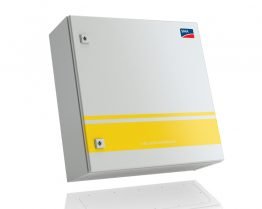
2014 Intersolar Award winner: the SMA Fuel Save Controller
3. SMA Fuel Save Controller
The SMA Fuel Save Controller provides the perfect interface between the gensets, PV systems and loads, managing demand-based PV feed-in into the diesel-powered grid. As the central component of the SMA Fuel Save Solution, it ensures maximum security with reduced fuel costs and minimizes CO2 emissions. The SMA Fuel Save Solution can achieve 60 percent of PV capacity compared to installed genset capacity. This means 600 kW of PV power can be generated from one megawatt of the installed genset power. The Fuel Save Controller consists of three modules:
- PV Main Controller Module
Controls PV power injected into the Diesel grid. Provides optimal PV feed-in capacity by evaluating current genset and overall load status.
- Interface Module
Records and transmits data and setpoints as the interface between the PV Main Controller and inverters.
- Data Acquisition Module
Quickly and precisely analyzes the current load and grid conditions in the system and transmits the data to the PV Main Controller Module.
4. Diesel genset
In grid-remote regions, pure diesel systems often provide the energy for industrial applications. They constitute the local grid, ensuring a constant power supply to all connected users. Because the gensets require a constant fuel supply, they are often the system’s highest operating cost. In regions with weak utility grids, diesel gensets often serve as a backup during grid power outages.
5. Genset system house
This includes the monitoring and control systems for the diesel gensets. The genset system house is the central terminal and point of common coupling
6. Optional storage batteries
To boost the efficiency of the entire energy supply system, it is advisable to include a storage battery. When solar irradiation is insufficient or energy is needed after dark, the storage battery supplies the required energy, ensuring optimal hybrid system operation. SMA is working on a battery inverter specifically designed for such industrial applications.
7. Industrial loads
Application specific load profiles, e.g., heavy duty industrial loads for mining or processing raw materials as well as for agricultural use, are generally characterized by loads with high starting currents and widely fluctuating load curves. Intelligent system management ensures that generation and load are perfectly matched. It achieves constant system stability by reacting quickly to generation and load performance spikes, e.g. when a conveyor belt is turned on.
When and where does a photovoltaic diesel hybrid system make sense?
For industrial large-scale loads in remote regions, complementing diesel gensets with photovoltaics is the ideal solution under the following conditions:
- When the effective cost of diesel exceeds one US dollar per liter.
- When intelligent communication between the genset and PV systems facilitates demand-oriented use of PV power.
- When local solar irradiation conditions allow the use of PV (especially economically viable with PV yields above 1,500 kWh/kWp)
Conclusion
Photovoltaic diesel hybrid systems can be amortized especially quickly in sunny regions, with little or no grid access. SMA system technology maximizes the use of solar energy in combination with diesel aggregates. For industries such as mining; raw material processing; agricultural companies such as flower farms and water desalinization systems and tourism facilities with a high energy demand low power generation costs, quick operational readiness, maximum reliability and availability are fundamental. The environmental benefits are also convincing: CO2 emissions and noise pollution are significantly reduced, minimizing the environmental impact. Environmentally friendly and cost-effective? Yes, we can do that.
Read more in our brochure “SMA Fuel Save Solution” (PDF)

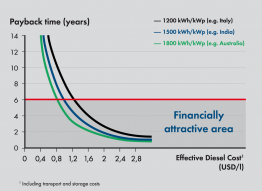
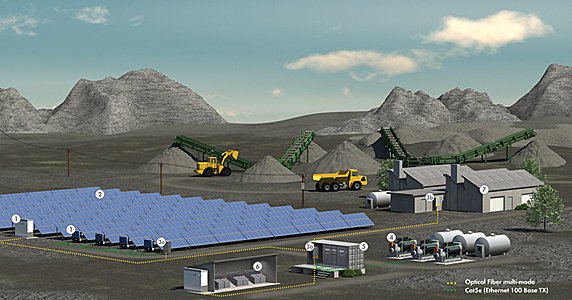
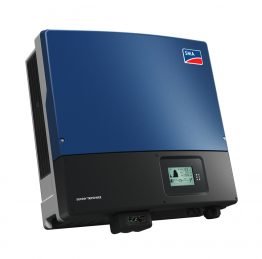
In case we need to run a back up DG set in parallel to PV units, do we need to mandatoryly have a battery ? What’s the guideline for DG set sizing . There will be a grid connection as well. A proposed connection diagram using SMA inverter would be appreciated.
Dear Sirs,
kindly please will you add the locations of west of Sudan towns (El Daein, Al Fashir, El Geneina etc,,,)-Darfur state to Sunny Design software, all rural areas in Darfur state and localities have a shortage of power and already we have some SMA equipment there, we are planning to installed hybrid pv in this areas, we do appreciate your responses
Dear
I have 2 x100 kva diesel GENSET for the load is around 180 kva. And want to install PV system to utilize the maximum daytime.
1) Now questions is can we sync 2 x 100 kva system with PV system. And the load gets shifted from 90 to 170 kva at regular intervals as some motor stops few seconds in cement factory plant. Is there possible solution and what it will be?
2) how the load has to be distributed between GENSET and PV system. Perkins Genset is recommend to have at least 50% load aa suggested by vendor.
3) can fuel saver can be integrated
4) as the battery cost is too high might go for 10 – 20 min battery backup, other wise without battery.What’s your recommendation.
5) region is pakistan
Hi Ahsan,
Thank you for your request. My colleague will contact you directly to help you with the system design.
Kind regards,
Anke
Thanks for this useful info.
I have one question about the minimum load in this system. Does this system (PV/Diesel Solution) make sense for Average load less than 100 KW?
I want to install PV-Diesel Hybrid system of 01 MW with energy storage. I study about the SMA Fuel Save Solution.
My question is that PV and Gen-set feed to load at same time ? with fuel save controller.
If yes, then what if the gen-set will be in running all the time ?
I want Priority as 1st PV, 2nd Battery and 3rd gen-set. Is it possible ?
Dear Fawad,
that is exactly how the SMA Fuel Save Controller operates a hybrid plant. You can see it in this commented log of a real plant.
In the morning, the solar system unburdens the generator until the generator minimum load is reached.
Then, the battery is charged to prevent from curtailing solar. Energy is pushed into the battery for later use.
In the evening, the battery releases energy into the grid.
In this example, it is a relatively small battery with capacity to cover around 20-30 minutes at nominal power. This is especially useful to run a small genset (much smaller genset nominal power than the load) during daytime.
Of course you can also choose a larger investment with batteries covering 24h. Although technically nice, this will most probably not be the way of maximized profitability 😉
If you need help in designing your system and in sizing the components, feel free to use our free-of-charge design service. You may read here how to get our support easily.
Sunny regards,
Christian
Dear SMA team ;
our target of the PV system installed to reduce the consumption from the grid and Genset
We installed inverter STP10000 TL-20 for PV system 9.5 kWp . the system is connected to grid and inject power to the gird, during grid off the genset start up the inverter stop to inject power .
would you please to advice me how can I inject power during grid off and genset start up?.
please support with your advices
Dear Mohamed,
this is a function contained in SMA Solar Inverters. As soon as the inverters see a grid (regardless if public grid or a generator) they will start to feed in when the grid parameters like voltage and frequency are in an acceptable range. But this is dangerous as inverters would feed in as much as possible. If there is no load to be covered (for example because of a tripped fuse), the solar inverters would fire energy into the generator and blow it up. This is why your inverters are most probably disconnected when there is no grid.
You have two possibilities:
1) Add a Sunny Island with a small battery. The Sunny Island can coordinate grid, genset and solar to run the sources together in an optimized way
2) If you plan to extend the solar share to 150kW and more, it would be feasible to add a Fuel Save Controller that is able to manage multiple gensets and more solar power with or without storage.
I hope this helps. If questions are left, feel free to ask here again.
Sunny regards,
Christian
Dear Mr Christian
Greatings
1.I just want know the maximum saving of fuel in percent during day time with your fuel saving controller technology in the areas of 1500hours to 1700hours of sun shine?
2. What is the maximum PV size to connect with the DG ? to be clear If I have 380KVA DG what size PV panels Should I propose to connect with it for a maximum saving during day time with out energy storage in the areas of 1600hours sun shine?
3.MY customer having 380KVA DG consumes 900liter per day(in 24hours) what he will expect to save per day ?he has no data day time and night time consumption? and what size solar panels do you propose for maximum saving?
And I need SMA PV diesel hybrid system division or representatives in Dubai, send me their address
I am waiting for your respond
Thank you
Dear Zeremariam,
thanks a lot for your interest in our Fuel Save Controller!
The amount of fuel savings that can be reached as well as the amount of solar that can be connected to your genset depends on different aspects and cannot be answered without some details – that is why we employ a team of experts who deal with these questions every day.
To have our experts do a free calculation of your plant, please just follow this article: From Idea To Real Hybrid System – How To Start?
You can find a lot of references here:
References
We have got a subsidiary in Abu Dhabi that covers sales, planning, commissioning and service of solar-diesel-hybrid systems. As soon as we know how your plant will look like, we will bring you in contact with an appropriate sales representative in Abu Dhabi.
Looking forward to hear from you!
Sunny regards,
Christian
Dear SMA team ;
I am designing hybrid system for a mobile station, the load capacity is 15.6 kwh ,
i need to feed the load with PV during daylight hours , then batteries and after that generator will start up when batteries discharged .
please support with your advices
Hello Mohamed,
please have a look at this. There you can find a lot of information, all about Fuel Save Solutions.
Kind regards, Jennifer
Hello,
Can you let me know if the PV power plant to DG ratio is 80:20 will this still work. We have a load of 130 KW and have space for 100 KW solar plant installation. If we use the diesel generator just for of 30 KW will this combination still work? What can be the minimum and maximum ratio of Diesel Generator to solar PV Power plant?
Dear Lokesh,
usually the minimum load at which a genset can be continuously driven varies by manufacturer and is between 25% and 35% of the gensets nominal power. Sometimes even up to 40%.
A possible solution could be to use a much smaller generator during low-load times. Then 25% of that small gensets nominal power would be much lower and you could have a greater solar share.
You may use our design tool Sunny Design to see how this affects the solar share and the economical outcome of your plan.
Sunny regards,
Christian
We have DG Set of 80 & kw 160 kw. We want to install 80kw soltyrar PV system for Food Industry.
Can we run hybrid mode with SMA Sunny Inverter. What will be price of matching capacity & how quickly we can get it.
Kindly respond quickly
SM Sahay
Dear SM Sahay,
it is great to hear about your project. To make a proposal for components, we need some more details. Could you please download and fill in the Solar Diesel Hybrid Questionnaire and send it to FuelSaveSolution@sma.de ?
I am looking forward to hear from you.
Sunny regards,
Christian
we’re bidding for a similar project in Kenya, which of your regional offices is responsible so we can engage?
Dear Charles,
please get in touch with SMA South Africa. I will send the contact information to you by email.
Sunny regards,
Christian
what are your suggestions for 4MW PV diesel hybrid system? central or string type
Dear Rana,
the choice for the one or other inverter type is a tradeoff between costs and flexibility.
On the one hand, central inverters are cheaper concerning price per kW than decentral inverters and also the installation is usually faster and therefore cheaper.
On the other hand, if an issue occurs with one central inverter, a large part of the solar plant stands still until the issue is solved. In case of using decentral inverters, the part of the solar plant that goes offline on issues is much smaller. Decentral inverters are also advantageous when the solar modules are distributed over different locations. It is also a question of expected load and genset useage. If the share of pv power compared to genset power gets too high (for example due to low load), it can make sense for grid stability to disconnect part of the solar inverters from grid to keep the system stable. If using decentral inverters, the FSC-20 can disconnect each single inverter if needed which reduces losses compared to dropping a central inverter block. Also if no medium voltage grid exists for a central inverter to be connected to, decentralized inverters are the option in low voltage grids.
I hope this answers your question. If anything is left unclear or you need further information, please let me know.
Sunny regards,
Christian
Hi,
Thank you for posting this. This is a very interesting topic and would help a lot of people who have been scratching their head wondering this is totally possible. We’re currently evaluating a suitable inverter for our system which is connected to grid. We also have standby diesel generator set when the grid goes out and it’s becoming normal rather than exception nowadays. Looking at the first item above, seems Sunny Tripower can be used for this. Looking at specific model, could we use Sunny Tripower 30000TL-US be used with 500KW diesel generator?
Thank you,
Mark
Hi Mark,
please contact the local SMA sales department to get assistance in this case.
Regards, Lucas
Hi Lucas,
Do you have SMA sales office here in the Philippines? If so, could you provide the contact details?
Thank you,
Mark
Hi Mark,
please contact Sales@sma-australia.com.au, the colleagues over there are responsible for the Philippines.
Regards, Lucas
Hello,
Can you please send us the contact of SMA service Engineer available to suggest us the best PV Diesel solution for one of our client based in Gujarat. Total Connected Load connected at site is 50 KW.
Available space for Solar PV Plant at site = 20 KW.
Requirement: 20 KW Solar On Grid with Net Metering and a DG set which will keep the Solar PV system on during grid failures.
Pls suggest.
Thanks,
Hiren
Hello,
Please contact SMA India, they can help you with your request.
Best regards,
Julia
Hi Leonie,
I am designing hybrid system for a complex in Myanmar and intends to use SMA Sunny Tripower for system whose capacity is of 200 kWp. Can I use the gensets as the virtual grids in case a blackout occurs.
Hi Trung,
Thank you very much for your inquiry and your interest in the SMA solutions for PV hybrid applications. In general it is indeed possible that the Sunny Tripower inverters use the gensets as a reference grid. In this case every kWh produced by the solar array does not need to be produced by the gensets and thus fuel can be saved. However, it is important to follow certain system design rules in order to be able to maintain system stability at any time. To be able to evaluate a suitable system concept I would recommend to contact the SMA engineers for support. Your first contact for you being located in Vietnam would be the SMA subsidiary in Thailand. You can find the contact details on http://www.sma-thailand.com/. Here’s a form that you could try to fill in: http://en.sma-sunny.com/files/2014/12/PV-Hybrid-Questionnaire-Light-v2.0.docx
Best regards,
Leonie
Madam, We have been lately offered this SMA product through our subdealer in India. We have scope to work on the same but we are running having Gas turbine and not DG sets. So, can we integrate SPV’s with GT sets. If require we will send you the details for your feasiblity.
Thanks a lot for your request. I will forward your message to our specialists and they will get in contact via email.
Best regards
Leonie